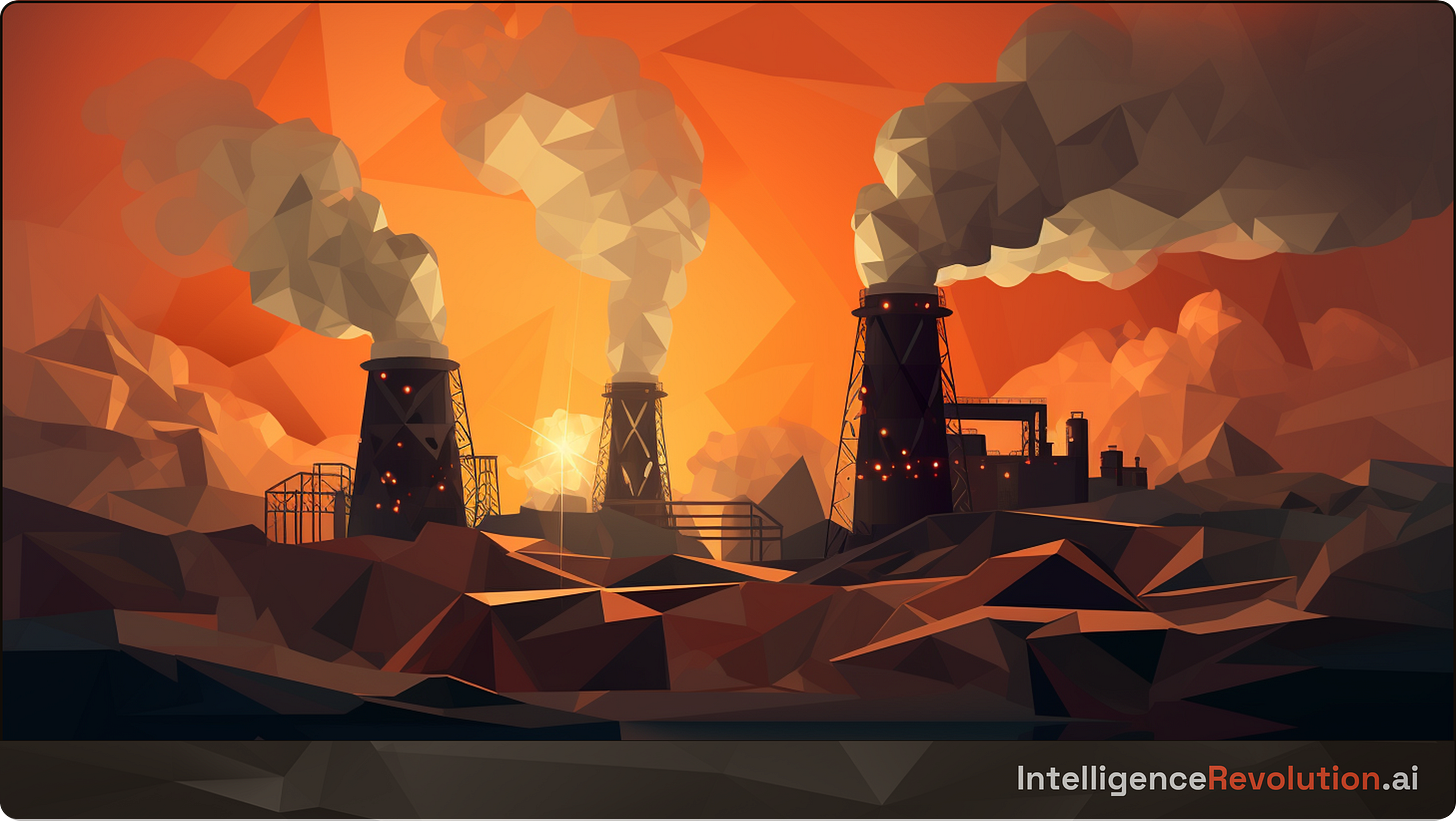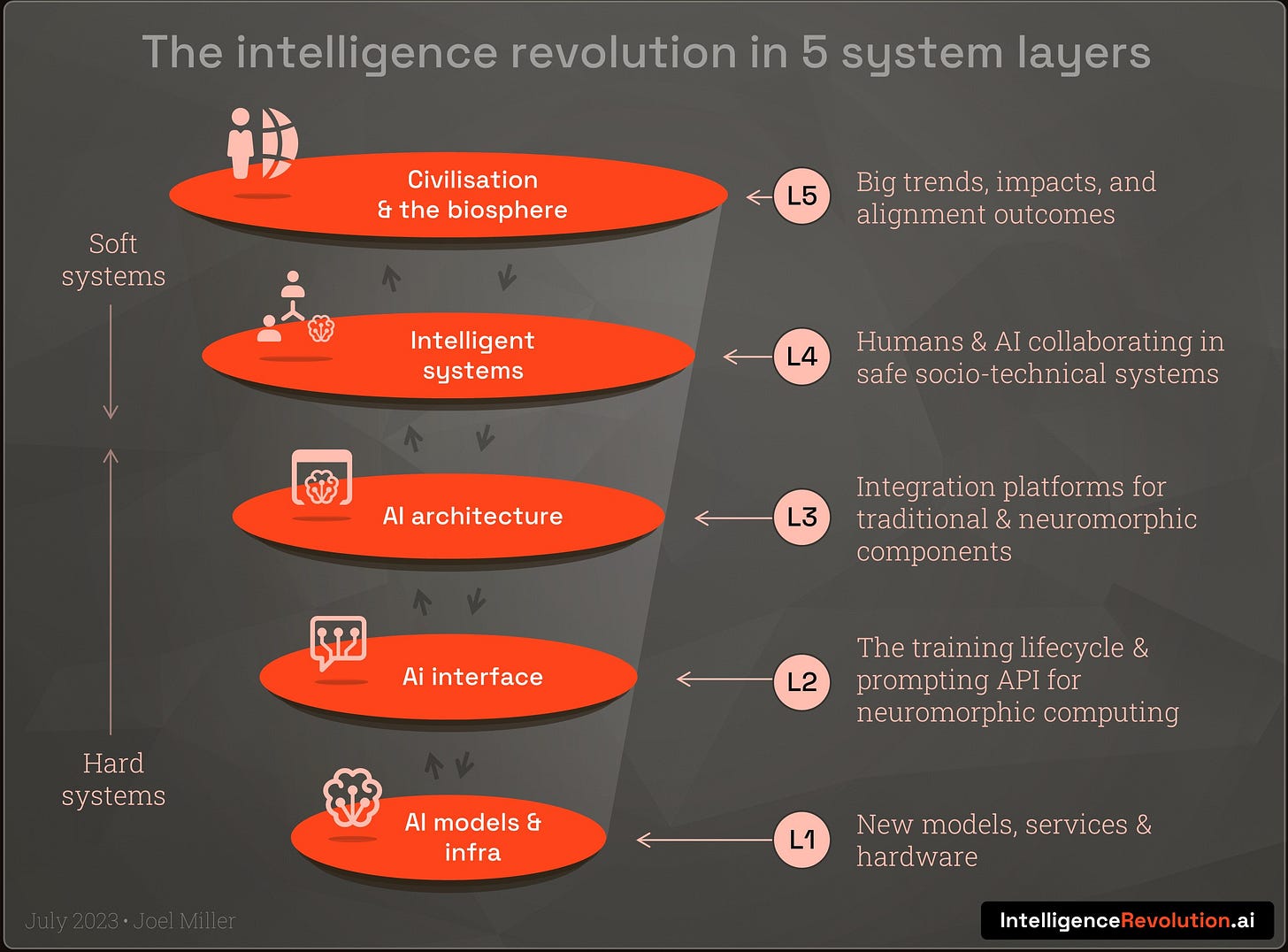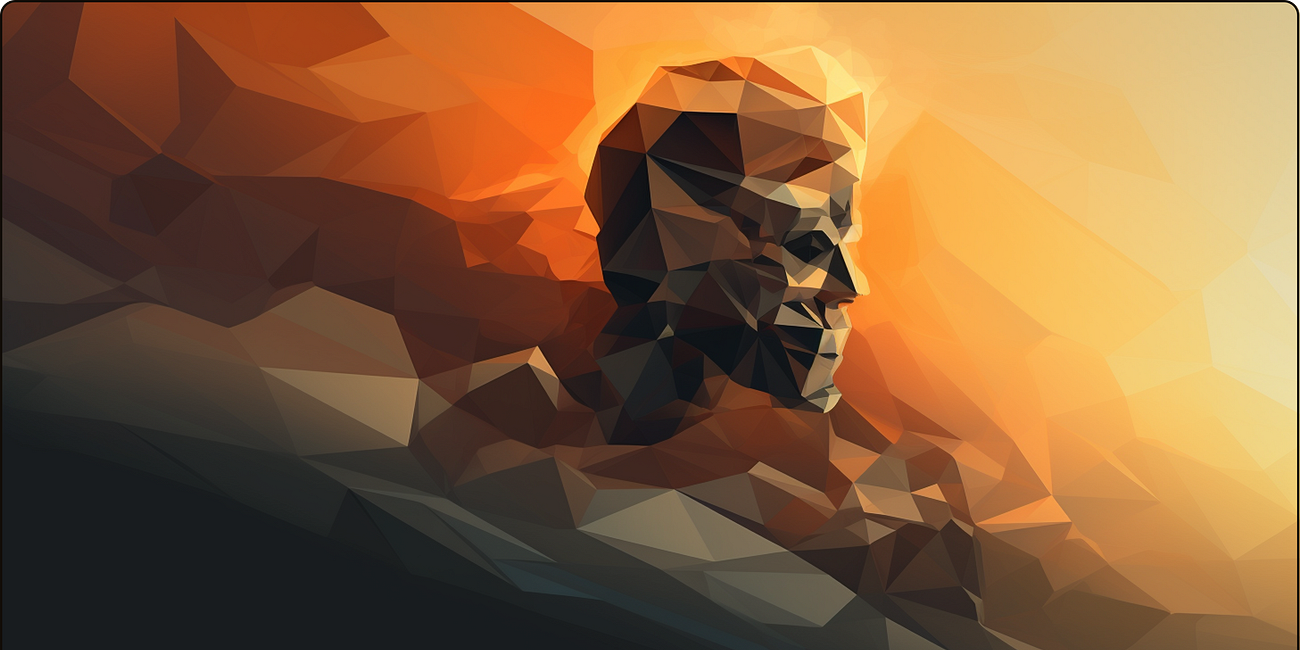From iron to AI: Introducing the intelligence revolution
Exploring the perils of progress without foresight or systems thinking
Throughout the course of its known history, intelligence has always been rooted in the biological and shaped by the influences of thermodynamics, geography, evolution, and conscious experience. But now the relentless post-Turing progress of the 'information age' appears to have created a new platform for intelligence. The machines are figuring things out, getting creative, and thoughtfully channelling our knowledge. These rapid developments have surprised everyone, and quite suddenly we're holding the ultimate double-edged sword… we're at the beginning of what can only be described as an intelligence revolution.
The intelligence revolution narrative
The IntelligenceRevolution.ai thesis is that a ‘revolution’ is now in train that will be powered by a hybrid population of humans and intelligent machines. 'Artificial' intelligence is a highly anthropocentric label; we must ultimately come to understand that intelligence is not real or artificial but is rather the effective completion of cognitive activities, and as such we need a broader narrative than our current focus on ‘AI’ to describe and understand this new age.
Whilst the universality of our new intelligent machines is still limited; they have fewer long-term limits on their population numbers and ability to learn and work efficiently together. We believe that homo sapiens had smaller brains than Neanderthals (and brains only moderately larger than primates) and yet our ability to out-collaborate other species gave us a crucial competitive advantage. Significant human progress has come from working effectively together in larger and larger communities, and self-improving with new communication and collective adaptation tools such as maritime trade, nation states, science or the printing press.
The AI population is now growing and improving meaningfully, and the ways it will coordinate and develop will not be limited entirely by computational power or data. A successful intelligence revolution will be one where we achieve optimal human-machine collaboration, adapting safely to this new world, expanding the sum of creativity, solving the biggest problems we face collectively, and fulfilling the human-machine potential. But this won’t be easy, and there are clearly many ways in which this could go awry.
New perspectives
Faced with such high-stakes uncertainty and opportunity, we need diverse perspectives, new mental models, and better practical frameworks and tools. IntelligenceRevolution.ai aims to highlight the deepest AI thinking, experiments, and insights, in an information environment where the noise is deafening.
This introductory article will suggest the first two of multiple ways to think about the revolution. As is said of models; 'all are wrong, some are useful,' so these are work in progress and I'm keen for feedback.
We start with:
A cautionary tale: Humans (and OK perhaps AI too) are unique in our ability to actively reflect on the past. The industrial revolution catalysed the most profound social and technological changes in human history. Period. It serves as the prime source for prescient stories that connect the technical to the societal, along a violent 300-year learning curve. We must try to avoid being quickly 'doomed by repeating the mistakes of our past'.
A layered systems model: If we are to tackle this revolution in the broadest sense, we also need a model that can link abstracted debate about civilization and the biosphere all the way down to the technical level where the revolution is being powered by software and silicon chips. If the industrial revolution suffered from short-sighted, mechanistic, and linear viewpoints, the intelligence revolution must be built on systems thinking, moving on from the fallacies of understandability, and the control of time and motion, to considering complexity, interconnection, and collective adaptation.
A warning from history
“On every side, and far as the eye could see into the heavy distance, tall chimneys, crowding on each other, and presenting that endless repetition of the same dull, ugly form, which is the horror of oppressive dreams, poured out their plague of smoke, obscured the light, and made foul the melancholy air.”
Charles Dickens
I was born in Shropshire, a few miles from the birthplace of the industrial revolution. Back in the early 1700s, smoke, fire, and iron began to scar the agricultural landscape in this quiet corner of England. Raw materials and coal were combined in iron forges, delivering advances in energy capture and a new abundance of material resources. This would ultimately change us from pre-industrial farmers at the mercy of a powerful biosphere to the architects of planet-scale and extra-planetary systems and of a climate-crisis. Today when I return to this most rural of English counties, only overgrown and rusty remnants of this world-changing technology remain.
The intelligence revolution is at a similarly early stage and promises an equivalent step-change in the abundance of intelligence. Before we underestimate the significance of our prosaic new tools, we must understand that the future of intelligence will manifest in radically different and unpredictable ways. The important thing to grasp is that today, like then, a confluence of factors has resulted in a material change in a set of system dynamics that are now inexorably in motion.
If I had been born 300 years earlier, seeing chimneys spring up, I would have had no conception of how things would play out. With a life expectancy of under 40, I would have not lived to see much of their impact. We can't really blame our pre-industrial ancestors for not thinking ahead. But history in the 21st century is on fast forward, and all of the infrastructure is in place to allow for rapid AI progress. Much like through the industrial revolution, today's solutions are about to become tomorrow's problems, just much more quickly. Iron gave us the ability to create more powerful machines; new intelligence may develop the ability to create new intelligence that itself creates new intelligence, and... it's clear this time around, we must deploy every facet of our extra 300 years of experience.
What is the role of regulation?
When commentators discuss an uncertain AI future in this way, it can lead to a sense of unease, and the natural reaction is to suggest we slow down, limit, or regulate heavily. The forge owners of Shropshire and the politicians of the era had the same debate, but they had no meaningful impact on the ultimate development of the steam engine, the railways, mechanized war, the rise of communism and fascism, the development of atomic weapons, the space race, or the internet. They could not 'control' their unfathomable future in any useful way other than by randomly slowing parts of an inexorable process. Simplistic regulation that only looks backwards, coupled with hope that the modern-day forge owners of Silicon Valley alone can engineer safe AI in perpetuity, represent a wilful failure to learn from history.
Given that they couldn't un-invent their new technology, and regulation would have had little long-term effect, what could our forbearers have done in Shropshire 300 years ago? What early steps could have prevented the creation of a global industrial system that powers on, even as it causes parts of our biosphere to experience the highest temperatures for 120,000 years?
A systems thinking response
They could have had the flexibility to join seemingly unconnected dots and understand that what they were really forging were not just iron but bio-socio-technical systems. New highly mechanized and recursive 'intelligent systems' powered by the confluence of raw materials, investment, global supply networks, changing attitudes, creativity, accelerated by their new machines. This thinking was as available to them as it is to us today. Taking a systems view from day one would have been the best way to shape what was to come.
“Systems thinking is a discipline for seeing wholes. It is a framework for seeing interrelationships rather than things, for seeing ‘patterns of change’ rather than ‘static snapshots.”
Peter Senge
By the early 1800s, some systems thinkers like Fourier had a sense of the situation:
“The establishment and progress of human societies, the action of natural forces, can notably change, and in vast regions, the state of the surface, the distribution of water and the great movements of the air. Such effects are able to make to vary, in the course of many centuries, the average degree of heat; because the analytic expressions contain coefficients relating to the state of the surface and which greatly influence the temperature.”
Joseph Fourier
Sadly, the prevailing dogma, and ‘tragedy of the commons’ confined this thinking to the margins, and even 200 years later, there remains some who won't accept climate change is the direct result of our activity. We have a present-day alignment problem where our overall human-machine system is not optimising for our best long-term survival objectives. We have modified our environment to an extent to which we must modify or essentially re-align how we operate as a species.
So what specifically can and must we do differently this time around?
A systems model
It's useful to break the intelligence revolution down into systems. Systems thinkers look at the whole - in this case, it's what would be termed a 'wicked problem'; how do we successfully navigate this complex revolution - and then they look for the various subsystems that make up that whole. Analysing those subsystems, they look for relationships and gather the many competing perspectives that are inherent when humans are involved. They seek to find the leverage points that can improve outcomes whilst constantly monitoring those outcomes at every level.
IntelligenceRevolution.ai will draw from this approach, and this article proposes 5 approximate systems groupings or for want of a better word ‘levels’, as follows:
Level 5: Civilization and the biosphere
Zoomed out, we have the neo-cybernetic whole - the ultimate 'soft' chaotic system of humans, machines, and their environment. We need to be on the lookout for trends and emergent change driven by the inner loops of new purposeful activity accelerated by computation. This is the level at which alignment, adaptive management, and collective cognition can be analysed and can guide the next level.
Level 4: Intelligent systems
This is where the rubber really hits the road, and humans and AI collaborate in new socio-technical systems. We need to find the most effective ways to get things done at scale with AI, leveraging new variants of design, UX, ethical product and business thinking, and at all times considering the consequences, deep interconnections, and impacts of our work. Our current knowledge jobs are going to be displaced, but our knowledge is the lifeblood of AI. We need to design a new intelligent hyper-system that can sustain us, reward contribution, provide equity, and allow us to focus intelligence both human and machine on the biggest challenges. We also need hyper-systems that can manage the threats from mis-aligned and malicious actors, both human and machine. In summary, we need to upgrade the systems of today to safely accommodate a vast new population of intelligent entities.
Level 3: AI architecture
New intelligent systems need new software engineering approaches and will be built on platforms that combine traditional and neuromorphic computing. The cloud platforms are offering myriad AI components and frameworks, and the open source community is innovating daily. These architectures must be tested and matured to encourage positive feedback loops by default, and to have safety and optimal intelligent system design built in.
Level 2: The AI interface
Neuromorphic computing is very different from our traditional predictable command based symbolic systems. It requires training and tuning lifecycles for models that raise new questions, from intellectual property to the potential for machines to train themselves. Interacting with AI involves the exploration of ‘prompting’ or natural language interfaces, and multiple modalities (words, images, and sound). This neuromorphic world is unpredictable; capabilities are emergent, and it has dizzying creative potential. This new layer will have deep implications for the intelligent systems we build on-top.
Level 1: New AI models and infrastructure
The transformer model, LLMs, and their underlying attention architecture are the current cutting edge, as are the latest AI chips and high-performance computer clusters. New models will emerge, and quantum computing could change-the-game still further. Unlike the relatively slow pace of the industrial revolution, it's likely we'll see daily developments, any one of which (much like the ChatGPT moment) might result in far-reaching consequences on the systems above and our whole.
Conclusions
The industrial revolution provides a cautionary tale of rapid technological advancement, and integration of machines without foresight. Of socio-technical engineering without safety mechanisms built into systems from the start. We cannot put the AI genie back in the bottle or predict the future; adopting a systems thinking perspective can help us learn from the past, monitor the present, and proceed mindfully.
The machine’s danger to society is not from the machine itself but from what man makes of it… for the man who is not aware of this, to throw the problem of his responsibility on the machine, whether it can learn or not, is to cast his responsibility to the winds, and to find it coming back seated on the whirlwind.
Norbert Wiener
We have a priceless advantage over our ancestors; they had no widespread knowledge of planet-scale change, no solid data that could prove their intuition that they were part of a system over which they had significant influence. We should look beyond the software and the hardware, consider the 'whole'. The industrial revolution changed everything, and the intelligence revolution will likely transform society even more profoundly in a fraction of the time. The intelligence revolution is not limited to human or artificial but to our collective ability to adapt and grow.
Every one of us owes it to future generations to engage in this this process deeply, to be guided by an understanding of history, and to use broad systemic exploration as we shape the future of intelligence. There are no easy answers, but with diverse thought and flexibility, we can write a chapter in the story of intelligence that is not of disaster foretold, but of potential fulfilled.
Subscribe to understand the IntelligenceRevolution.ai.
To explore intelligence and its quantification, read this follow-up article:
Can intelligence be revolutionised?
The intelligence revolution is in motion. Recent and significant growth in access to intelligent machines has been led by transformer architecture based AI models. If you haven't already, I would encourage you read my post introducing the intelligence revolution





